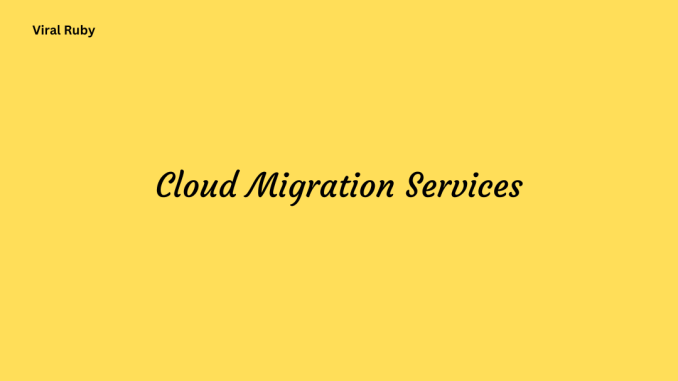
Cloud Migration Services Challenges and Benefits
Introduction to Cloud Migration Services
Cloud migration services refer to the process of transferring an organization’s applications, data, and infrastructure from on-premises environments to the cloud. This transition allows businesses to leverage the benefits of cloud computing, such as scalability, flexibility, cost-efficiency, and improved security.
Cloud migration services are offered by various providers and consultancy firms that specialize in assisting organizations throughout the migration journey. These services encompass a range of activities, including planning, assessment, implementation, testing, and post-migration support.
The key objective of cloud migration services is to streamline the migration process and minimize disruptions to the business operations. These services often involve the following steps:
Assessment: A thorough evaluation of the existing infrastructure, applications, and data to determine their readiness for migration. This step helps identify any potential challenges, dependencies, or compatibility issues that need to be addressed.
Planning: Developing a comprehensive migration strategy that outlines the approach, timeline, resource requirements, and potential risks. This phase involves defining the target cloud environment, selecting the appropriate cloud service model (such as Infrastructure as a Service (IaaS), Platform as a Service (PaaS), or Software as a Service (SaaS)), and considering factors like data security, compliance, and regulatory requirements.
Data Migration: Transferring the organization’s data from on-premises systems to the cloud. This process involves ensuring data integrity, minimizing downtime, and implementing efficient data transfer mechanisms.
Application Migration: Moving the organization’s applications to the cloud platform while ensuring compatibility, performance, and functionality. This step may involve re-architecting or re-platforming applications to optimize their performance in the cloud environment.
Testing and Validation: Conducting rigorous testing to verify the functionality, performance, and security of migrated applications and data. This phase helps identify and address any issues before the final cutover.
Cutover and Go-Live: Executing the final migration steps, including transferring the remaining data, redirecting user traffic, and ensuring a smooth transition to the cloud environment. Post-migration support is provided to address any immediate issues and ensure the successful operation of the migrated systems.
Cloud migration services offer several benefits to organizations, including:
Scalability: The ability to quickly scale up or down computing resources based on demand, allowing businesses to optimize their infrastructure and reduce costs.
Flexibility: The cloud offers a wide range of services and deployment models, allowing organizations to choose the most suitable options for their specific needs.
Cost-Efficiency: Cloud migration services help organizations reduce capital expenditure on hardware, maintenance, and upgrades, while also offering pay-as-you-go pricing models.
Enhanced Security: Cloud providers often have robust security measures in place, including data encryption, regular backups, and disaster recovery options, ensuring better data protection than traditional on-premises systems.
Improved Collaboration: Cloud platforms enable easy collaboration among teams, facilitating remote work, real-time document sharing, and seamless integration with other cloud-based tools and services.
Benefits of Cloud Migration Services
Here are some key advantages:
Scalability: Cloud migration allows businesses to easily scale their infrastructure and resources up or down as per their needs. It provides the flexibility to quickly adjust to changing demands, ensuring optimal performance and cost efficiency.
Cost Savings: Moving to the cloud can lead to significant cost savings. Instead of investing in expensive hardware and infrastructure, businesses can leverage the pay-as-you-go model offered by cloud service providers. This eliminates the need for upfront capital expenditure and allows organizations to pay only for the resources they use.
Enhanced Security: Cloud providers invest heavily in robust security measures to protect their infrastructure and customer data. By migrating to the cloud, businesses can benefit from advanced security features such as data encryption, regular security updates, access controls, and disaster recovery capabilities. Cloud providers also comply with industry-standard security and compliance regulations, reducing the burden on businesses to ensure data security.
Improved Collaboration and Accessibility: Cloud migration enables teams to collaborate more effectively by providing a centralized platform for data storage, sharing, and collaboration. Employees can access files and applications from anywhere, using any device with an internet connection. This enhances productivity and streamlines workflows, particularly for remote or distributed teams.
Increased Reliability and Business Continuity: Cloud service providers offer high availability and redundancy across multiple data centers, ensuring that businesses have reliable access to their data and applications. In the event of a hardware failure or natural disaster, cloud-based backups and disaster recovery solutions help organizations quickly recover their systems and minimize downtime.
Simplified IT Management: Cloud migration reduces the burden of managing and maintaining on-premises infrastructure. Service providers handle routine maintenance, updates, and backups, allowing businesses to focus on core competencies and strategic initiatives. This frees up IT resources, enabling them to work on more value-added tasks.
Innovation and Agility: Cloud-based services provide businesses with access to a wide range of cutting-edge technologies and tools. Organizations can leverage cloud-native services like artificial intelligence, machine learning, and big data analytics to drive innovation and gain a competitive edge. The cloud also facilitates faster application development and deployment, enabling businesses to respond quickly to market demands.
Steps for Successful Cloud Migration
Cloud migration is a complex process that requires careful planning and execution to ensure a successful transition. Here are the key steps involved in a typical cloud migration:
Assess and Plan: Begin by assessing your existing infrastructure, applications, and data to understand their dependencies, performance requirements, and any potential challenges. Identify the goals and objectives of the migration, such as cost reduction, scalability, or improved security. Develop a comprehensive migration plan that includes timelines, resource allocation, and a roadmap for the migration process.
Choose the Right Cloud Provider: Select a cloud provider that aligns with your organization’s requirements and goals. Consider factors such as the provider’s reputation, reliability, security measures, scalability, and cost structure. Evaluate different cloud service models (IaaS, PaaS, or SaaS) to determine the most suitable option for your applications and data.
Data and Application Assessment: Conduct a thorough assessment of your data and applications to determine their suitability for migration. Identify any dependencies, integration requirements, and potential challenges. Prioritize applications and data based on criticality, complexity, and business impact.
Design Cloud Architecture: Develop a cloud architecture that aligns with best practices and your organization’s specific requirements. Consider factors such as scalability, availability, security, and compliance. Determine how your applications and data will be structured and distributed within the cloud environment.
Data Migration: Plan and execute the transfer of your data to the cloud. Assess the volume and complexity of the data to determine the most efficient migration approach, such as using direct network transfers, data transfer appliances, or online data transfer services. Ensure data integrity, minimize downtime, and perform thorough testing to validate the successful migration of data.
Application Migration: Migrate your applications to the cloud while considering compatibility, performance, and functionality. Depending on the complexity of your applications, you may choose to re-host (lift-and-shift), refactor, rearchitect, or replace them with cloud-native alternatives. Test your migrated applications to ensure they work seamlessly in the new cloud environment.
Security and Compliance: Implement robust security measures in the cloud, including access controls, encryption, and data protection mechanisms. Ensure compliance with relevant regulations and industry standards. Regularly monitor and assess the security posture of your cloud environment to identify and address any vulnerabilities.
Testing and Validation: Perform comprehensive testing to validate the functionality, performance, and security of your migrated applications and data. Conduct tests for different scenarios, including load testing, failover testing, and disaster recovery testing. Address any issues or performance bottlenecks before proceeding to the next step.
Training and Change Management: Provide training and support to your staff to ensure they are familiar with the new cloud environment and understand how to effectively utilize its features. Implement change management processes to minimize disruption and facilitate a smooth transition for employees and end-users.
Go-Live and Optimization: Execute the final cutover to the cloud environment, ensuring minimal downtime and disruption to business operations. Monitor and optimize the performance and cost-efficiency of your cloud resources. Continuously assess and optimize your cloud architecture, applications, and data to leverage the full potential of the cloud.
Remember that cloud migration is an ongoing process, and it’s essential to continuously monitor, evaluate, and refine your cloud environment to maximize its benefits and address evolving business needs.
Challenges and Considerations in Cloud Migration
Cloud migration comes with its own set of challenges and considerations that businesses need to address. Here are some key factors to consider:
Data Security and Privacy: While cloud service providers have robust security measures in place, businesses must ensure that their sensitive data is adequately protected during migration and storage. Compliance with data protection regulations and industry-specific requirements should be thoroughly evaluated to avoid any potential breaches or data loss.
Migration Strategy and Planning: Developing a well-defined migration strategy is crucial to ensure a smooth transition. Businesses need to assess their current infrastructure, applications, and data dependencies to determine the most suitable migration approach—whether it’s a lift-and-shift, re-platforming, or re-architecting. Careful planning, including resource allocation, timeline, and testing, is essential to mitigate risks and minimize disruptions to operations.
Application Compatibility and Integration: Not all applications and systems are easily migrated to the cloud. Compatibility issues may arise due to dependencies on specific hardware, operating systems, or software configurations. Integration challenges can also arise when connecting cloud-based services with existing on-premises systems. Thoroughly evaluating application compatibility and integration requirements is vital to ensure seamless functionality post-migration.
Network and Connectivity: Migrating to the cloud requires a reliable and robust network infrastructure. Adequate bandwidth and low latency connections are essential to ensure smooth data transfer and access to cloud resources. Evaluating network capabilities, potential bottlenecks, and redundancy options is necessary to maintain performance and minimize downtime during the migration process.
Cost Optimization: While the cloud offers cost-saving potential, businesses must carefully manage their cloud resources to avoid unexpected expenses. Understanding the pricing models of cloud service providers and optimizing resource allocation based on actual needs is crucial. This includes monitoring and optimizing usage, choosing the appropriate instance types, and leveraging cost management tools and services.
Vendor Lock-In and Portability: Businesses should be aware of the potential for vendor lock-in when migrating to a specific cloud provider. It’s important to assess the portability of applications and data between different cloud environments or consider adopting a multi-cloud strategy to maintain flexibility and avoid dependence on a single provider.
Organizational Change and Skill Set: Cloud migration often requires a shift in organizational culture and skill sets. IT teams need to adapt to the new cloud environment and acquire the necessary knowledge and expertise to manage and optimize cloud-based resources. Proper training, upskilling, and change management initiatives should be implemented to ensure a successful transition.
Regulatory and Compliance Considerations: Different industries and regions have specific regulatory and compliance requirements that need to be addressed during cloud migration. Businesses must assess the impact of data sovereignty, data residency, and privacy regulations to ensure compliance with legal obligations.

Leave a Reply